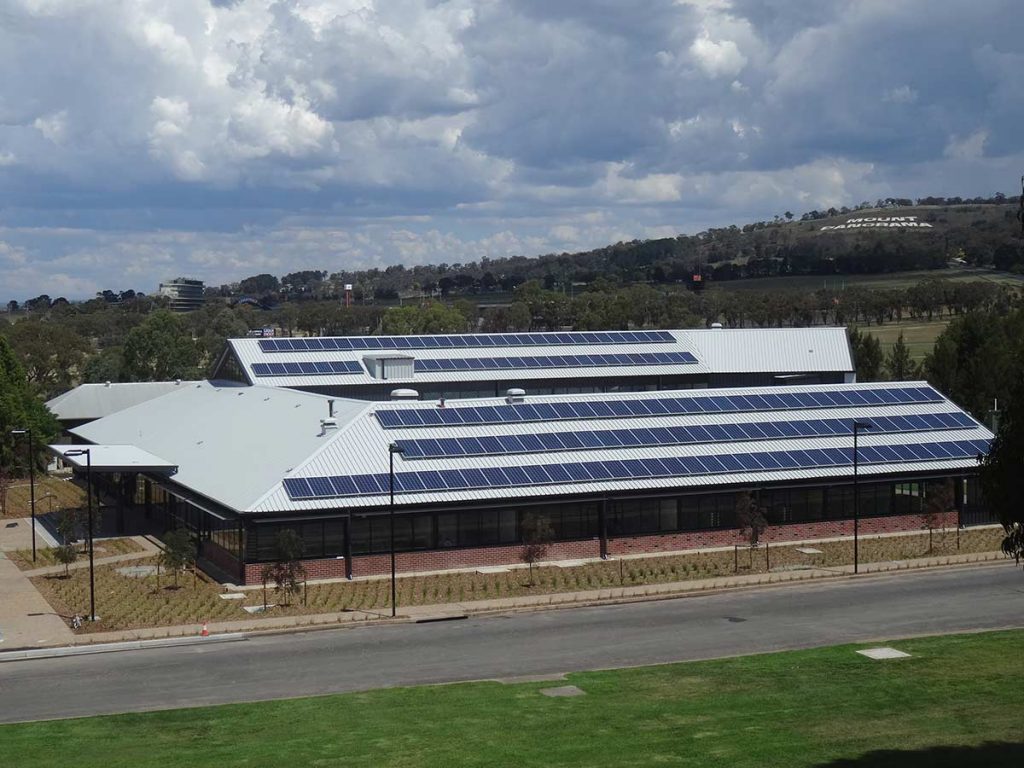It’s one of our time’s most widely discussed topics. From politicians to mums and dads, businesses to community groups and school students to universities – around the globe it seems people are talking climate change. Whether ongoing discussions among world leaders or general chat from water coolers conversationalists – it’s on everyone’s lips. Then there’s TV shows and books, conferences and seminars, podcasts and papers, cartoons and memes. And if you should Google ‘climate change’ it will tell you there are “about 799,000,000 results”.
That’s a lot of information and a lot of discussion. And rightly so.
So far-reaching are the ramifications of climate change (and its conversational companion, sustainability) that they’re shaping up to be THE issues of 21st century.
At Charles Sturt University we started the conversation long ago – in fact these issues are at the heart of who we are and all we do. Ed Maher, Sustainability at Charles Sturt manager, says it’s all part of our ethos, which is represented by the Wiradjuri phrase Yindyamarra Winhanganha.
“It means the wisdom of respectfully knowing how to live well in a world worth living in.
“Charles Sturt accepts the science. We recognise that we have a responsibility to act in a way that minimises our own negative impacts but also raises awareness and equips our graduates with the skills and expertise to play a positive role.”
Making a powerful statement
In April 2019 we issued a pretty impactful statement of intent when it comes to sustainability. Charles Sturt University’s then Vice-Chancellor Professor Andrew Vann said this statement was a significant milestone in our commitment to best practice in sustainability, including carbon neutrality.
“It builds a sustainability mindset to inform our decision-making and embed sustainability within the fabric of the university – within our practices, actions and life beyond the university.
“Charles Sturt recognises that climate change remains one of the single greatest environmental and social challenges that we face as a species, and will actively seek to be part of the global response that is needed.”
For us, sustainability blends environmental, social and economic considerations into our decision-making so we can help create a thriving and healthy society. It’s about improving the quality of life for all citizens without increasing the use of natural resources beyond the capacity of the environment to supply them indefinitely.
Ed says the principle is simple – everything we need for our survival and wellbeing depends, either directly or indirectly, on our natural environment.

“That’s why we need to nurture and take care of it. And that’s why, at Charles Sturt, we take our commitment to sustainability very seriously.”
Charles Sturt’s green gains
But we also know actions speak louder than words. And we continue to build on the gains we’ve made – including setting up Sustainability at Charles Sturt (the driving force behind our sustainability efforts) in 2008 and being certified as Australia’s first carbon neutral university in 2016.
Being carbon neutral is an ongoing goal for us at Charles Sturt. But do you know what it means and what’s involved?
Well, let’s just start by saying becoming a carbon neutral organisation is no small task. In fact, it’s a goal that sees us branch out and undertake a range of large and small initiatives. And these are carried out on our campuses and all over the world, by staff and students and many others on our behalf.
Ed knows that although the task is huge, the concept is simple: fund projects which will completely negate our carbon emissions produced each year.
Carbon emissions produced – carbon offset purchases = a carbon neutral Charles Sturt University.
“We’ve gone through a robust process in accordance with international standards to quantify what our overall carbon emissions inventory consists of for a calendar year. We then implement projects that mitigate those emissions. We procure accredited carbon offsets (which are projects that are being implemented by others with our funding assistance and on our behalf) to reduce carbon emissions at other locations and set them off against our own.”

A portfolio of green initiatives
And at Charles Sturt we’re savvy buyers – our offset purchases must also provide a vast number of social and environmental co-benefits.
“We go to tender for carbon offset providers to supply us with a proposed portfolio and we give them guidelines around the types of projects that we’re keen to back. For example, our criteria included a desire to support Australian projects – ideally those close to our campuses. Also, to be involved with endeavours with co-benefits which go above and beyond carbon reduction. They might increase local employment opportunities or provide habitat for endangered species.”
Our ‘carbon offset portfolio’ is as diverse as it is interesting. Take, for example, some projects we’ve been associated with recently.
Rimba Raya Biodiversity Reserve Project, Indonesia
An initiative by InfiniteEARTH, this project has two goals. Firstly, it reduces emissions by preserving around 64,000 hectares of tropical peat swamp forest – which is rich in biodiversity and home to the endangered Bornean orangutan. Secondly, it helps protect the adjacent Tanjung Puting National Park by creating a physical buffer along a 90km border.
Offset: 8557 tonnes CO2-equivalent
Solar Grouped Project (ACME Group), India
The project is a step towards supporting the implementation and installation of grid connected renewable energy power plants in India.
Offset: 22,573 tonnes CO2-equivalent
Zhangbei Lvnabao Wind Power Project, China
The main purpose of this project is to generate clean electricity through renewable wind energy sources.
Offset: 15,000 tonnes CO2-equivalent
CO2 Australia Creating a Better Climate Project (Reforestation), NSW
Numerous native eucalypts have been planted across central NSW during the past decade. These trees were selected for drought, disease and fire tolerance. This revegetation in heavily cleared areas reaps many biodiversity and environmental co-benefits.
Offset: 1923 tonnes CO2-equivalent
Going green close to home
But our annual carbon offset portfolio is by no means the only way we’re making a difference. Closer to home we’re always striving to become a more sustainable organisation – with a multipronged approach.
Ed describes the six areas which will drive Charles Sturt towards sustainability.
Onsite renewables. “We’ve already achieved quite a lot in this regard. Our solar program is being completed in two stages. The first stage was finished in 2017 in Wagga Wagga and it is rated at 1.7 megawatts of power. The second stage is currently well under way and is rated at 2.6 MW of solar power across the Albury-Wodonga, Bathurst, Dubbo and Orange campuses. It is due for completion by December 2019. The combined systems from all campuses could power more than 1,000 houses each year – enough for a small town.

“This solar-generated power is being used for anything that requires electricity across our campuses, firstly in the building where the power was first produced, then elsewhere on campus, and then even off-campus into the grid if we produce electricity surplus to our needs.
“They are significant savings. We currently spend more than $5 million each year on all our energy use, including gas so it’s important from a financial sustainability perspective that we take active steps to reduce these costs.
“While the two phases have cost more than $7.5 million to date, we are looking to be more than $700,000 per year better off.”
Ongoing energy efficiency. “Technological change continues to evolve, so there will always be more that we can do with our air-conditioning, lighting and hot water systems – to name a few.”
Energy Productivity. “We are an organisation that has grown fairly organically and we are now approaching how we operate in a sophisticated and structured manner. That includes being sensitive to our timetabling, preferencing the most efficient buildings and how we manage and occupy them. It’s about optimising the layout and density, negating the need for unwarranted spreading out across campuses. It includes managing how we heat and cool buildings. And finally we’ll look at decommissioning buildings that are past their used-by date in terms of efficient operation.
Clean transport. “With a fleet of more than 250 vehicles, Charles Sturt is transitioning from internal combustion engines to electric vehicles. This will see us move from fossil fuel sources to renewal energy sources.

Natural gas. “We are planning to move away from natural gas because there is no readily available renewable alternative to it. So our most practical alternative is to move towards full electrification of our campuses – which means we can source from renewables. Natural gas is a finite resource which is still a fossil fuel. Going electric helps eliminate emissions.
Offsite renewables. “Once we are done with onsite projects we will focus on sourcing from renewable sources. It’s not commercially viable to generate 100 per cent of our own electricity so we also need to source retail energy from renewable energy sources.”
“If we look more broadly at where we’re heading in the ongoing carbon reduction space, we’ve recently made a commitment to a 2030 clean energy strategy. We’re looking to eliminate carbon emissions – at the source – for those fuels we use on our campuses.”
Why are these initiatives important?
Ed explains that Charles Sturt’s Sustainability Statement refers to another Wiradjuri phrase: Nganga-dha garray-gu, bila-galang-gu! Yandu garray-bu bila-galang-bu nganga-girri nginyalgir.
Which means: look after the land and the rivers, then the land and the rivers will look after you.
“At Charles Sturt we want to be good stewards of our environment and regional communities. That mean’s getting things right in our own backyard.
“And we also want to model that behaviour. Because the real potential exists when we get our grads to be knowledgeable and skilled in these practices, so that when they become leaders and make decisions we will see a multiplying effect across the globe.
“We also see it as being part of as good corporate citizens. We demonstrate what is possible and seek to take others – businesses, communities, homes – along on the sustainable lifestyle and economic journey with us.
“And, lastly, many of these initiatives will allow us to be more in charge of our own destiny. For example, the energy market is very volatile and can be influenced by many factors. So by being proactive and generating energy and procuring energy from renewable sources with relatively fixed costs of generation it gives us better protection and control in that market.”
Did you know? Charles Sturt University is one of only two tertiary education providers to be named a finalist in two award categories in the 2019 Australasian Campuses Towards Sustainability Green Gown Awards.
Find out more about our green initiatives
Want to know more about Charles Sturt University’s green initiatives? Explore Sustainability at Charles Sturt’s content hub – and be inspired!
Are you interested in a career in environmental science and management? Would you like to come up with green initiatives to overcome environmental challenges and help ecosystems and communities grow and flourish?
Learn more about our environmental science courses. After all, the latest Excellence in Research for Australia National Report gave Charles Sturt University a ranking of 4, “above world average”, for our work in environmental science and management.


You must be logged in to post a comment.